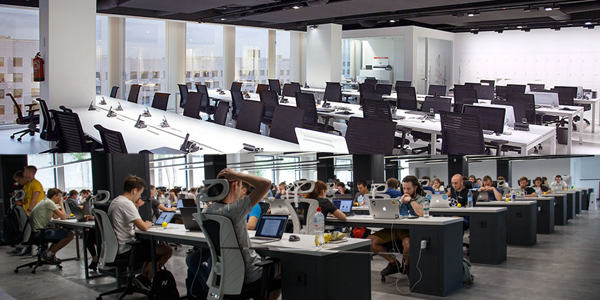In recent years new reflections on the productive space have been opened. How to overcome the disadvantage of an open space office?

Open-Space Office
We live in an over-supervised period of information, where companies seek to be competitive in the marketplace. The most significant source of competitiveness is found in the productivity of the employee; communication, creativity, and collaboration between them is necessary; actually, modern structures have increasingly sought to create offices with open spaces.
Open-plan offices are not only cheaper, but they also promote interaction between employees, well-being, and productivity as long as there is a synergy between what should be open and closed space. Studies conducted by Gensler in England on the workplace in 2016 show that 67% of UK workers are exhausted at the end of the working day because of their office environment.
The design of the offices is essential, poor acoustics and continuous interruptions can be reflected in the final performance of the employee. Dr. Nicola Millard, in her book Work Shift: The Death of Dolly, Dilbert, and Doctor No, assures us that it takes us between 8 and 20 minutes to return to the thought process after each interruption and that this happens every 3 minutes to be exact.
Continuous noise and lack of privacy are the main reasons for dissatisfaction; its effects on employees can be psychological, behavioral, and congenital. Prolonged loud sounds can contribute to physiological stress, such as spikes in blood pressure and heart rate. Continuous conversations, the laughter of variable volume, and sudden noises are considered essential forms of distraction. However, a quiet environment is just as much a cause of stress.
Open workspaces should meet the needs of individuals as well as teams, with balanced spaces that allow collaboration and individual concentration. Therefore, there are different systems on the market designed to redirect or mask the noise.
How to create a comfortable acoustic balance in a work environment?
Reducing and masking the sounds that we perceive as disturbing and stressful while creating a comfortable environment where there are dynamism and communication is no easy task. Open workspaces should be adapted to the needs of both individuals and teams, with balanced spaces that allow both collaboration and individual concentration. Therefore, various system redirect or mask sound to provide quieter in the working environment.
Experience from the test in workspaces has shown that the less the sound generated can be localized, the more comfortable it’s for people. The challenge is, therefore, to create an optimal homogeneous sound for this type of place.
At NewTec have dedicated their time and skills to perfect a unique membrane that redirects the sound of the music to 360°; all listening positions around the speakers have the same sound pressure level, providing a smooth sound.
This technical feature of omnidirectional sound distribution not only means that fewer speakers are required, but also that all information and frequencies are distributed evenly throughout the room. This mean a reduction in the cost of actively controlling the acoustic environment of the place, and it’s a good alternative if you are looking for an acoustic balance to increase employee satisfaction and productivity.
Increased comfort means increased efficiency!